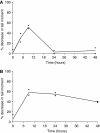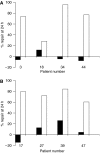Enhanced repair of DNA interstrand crosslinking in ovarian cancer cells from patients following treatment with platinum-based chemotherapy
- PMID: 17848946
- PMCID: PMC2360410
- DOI: 10.1038/sj.bjc.6603973
Enhanced repair of DNA interstrand crosslinking in ovarian cancer cells from patients following treatment with platinum-based chemotherapy
Abstract
Despite high tumour response rates to platinum-based chemotherapy in ovarian cancer survival is poor due to the emergence of drug resistance. Mechanistic studies in clinical material have been hampered by the unavailability of sensitive methods to detect the critical drug-induced effects in individual cells. A modification of the single cell gel electrophoresis (comet) assay allows the sensitive detection of DNA interstrand crosslinking in both tumour and normal cells derived directly from clinical material. Tumour cells isolated from 50 ovarian cancer patients were treated ex vivo with 100 microM cisplatin for 1 h and crosslink formation and repair (unhooking) measured. No significant difference in the peak level of crosslinking in tumour cells was observed between patients who were either newly diagnosed or previously treated with platinum-based therapy, or between tumour and mesothelial cells from an individual patient. This indicates no difference in cellular mechanisms such as drug transport or detoxification. In contrast, the percentage repair (unhooking) of DNA interstrand crosslinks was much greater in the group of treated patients. At 24 h in the 36 newly diagnosed patient tumour samples, only one gave >50% repair and 23 gave <10% repair; however, 19 out of 22 treated patient samples gave >10% repair and 14 showed >50% repair. The estimated median difference (newly diagnosed minus treated) was -52 (95% CI -67 to -28), and the P-value from a Mann-Whitney test was <0.001. In eight patients, it was possible to obtain tumour samples prior to any chemotherapy, and also on relapse or at interval debulking surgery following platinum-based chemotherapy. In these patients, the mean % repair prior to therapy was 2.85 rising to 71.23 following treatment. These data demonstrate increased repair of DNA interstrand crosslinks in ovarian tumour cells following platinum therapy which may contribute to clinical acquired resistance.
Figures





Similar articles
-
Evidence for different mechanisms of 'unhooking' for melphalan and cisplatin-induced DNA interstrand cross-links in vitro and in clinical acquired resistant tumour samples.BMC Cancer. 2012 Sep 28;12:436. doi: 10.1186/1471-2407-12-436. BMC Cancer. 2012. PMID: 23020514 Free PMC article.
-
Detection of oxaliplatin-induced DNA crosslinks in vitro and in cancer patients using the alkaline comet assay.DNA Repair (Amst). 2006 Feb 3;5(2):219-25. doi: 10.1016/j.dnarep.2005.09.010. Epub 2005 Oct 25. DNA Repair (Amst). 2006. PMID: 16253571
-
Detection of DNA crosslinks in peripheral lymphocytes isolated from patients treated with platinum derivates using modified comet assay.Neoplasma. 2013;60(4):413-8. doi: 10.4149/neo_2013_053. Neoplasma. 2013. PMID: 23581413
-
Nucleotide excision repair pathway review I: implications in ovarian cancer and platinum sensitivity.Gynecol Oncol. 2007 Oct;107(1 Suppl 1):S56-71. doi: 10.1016/j.ygyno.2007.07.043. Epub 2007 Sep 19. Gynecol Oncol. 2007. PMID: 17884153 Review.
-
Medical therapy of advanced malignant epithelial tumours of the ovary.Forum (Genova). 2000 Oct-Dec;10(4):323-32. Forum (Genova). 2000. PMID: 11535983 Review.
Cited by
-
Platinum rechallenge treatment using gemcitabine plus carboplatin with or without bevacizumab for platinum-resistant ovarian cancer.Int J Clin Oncol. 2022 Apr;27(4):790-801. doi: 10.1007/s10147-021-02103-7. Epub 2022 Jan 5. Int J Clin Oncol. 2022. PMID: 34985551
-
Association of Neo-Family History Score with pathological complete response, safety, and survival outcomes in patients with breast cancer receiving neoadjuvant platinum-based chemotherapy: An exploratory analysis of two prospective trials.EClinicalMedicine. 2021 Jul 17;38:101031. doi: 10.1016/j.eclinm.2021.101031. eCollection 2021 Aug. EClinicalMedicine. 2021. PMID: 34337367 Free PMC article.
-
Evidence for base excision repair processing of DNA interstrand crosslinks.Mutat Res. 2013 Mar-Apr;743-744:44-52. doi: 10.1016/j.mrfmmm.2012.11.007. Epub 2012 Dec 3. Mutat Res. 2013. PMID: 23219605 Free PMC article. Review.
-
Inhibition of carboplatin-induced DNA interstrand cross-link repair by gemcitabine in patients receiving these drugs for platinum-resistant ovarian cancer.Clin Cancer Res. 2010 Oct 1;16(19):4899-905. doi: 10.1158/1078-0432.CCR-10-0832. Epub 2010 Aug 18. Clin Cancer Res. 2010. PMID: 20719935 Free PMC article. Clinical Trial.
-
Poly (ADP-ribose) polymerase inhibitor therapy and mechanisms of resistance in epithelial ovarian cancer.Front Oncol. 2024 Jul 29;14:1414112. doi: 10.3389/fonc.2024.1414112. eCollection 2024. Front Oncol. 2024. PMID: 39135999 Free PMC article. Review.
References
-
- Colombo N, Van Gorp T, Parma G, Amant F, Gatta G, Sessa C, Vergote I (2006) Ovarian cancer. Crit Rev Oncol Hematol 60: 159–179 - PubMed
-
- Comess KM, Lippard SJ (1993) Molecular aspects of platinum-DNA interactions. In Molecular Aspects of Anticancer Drug-DNA Interactions, Neidle S, Waring MJ (eds), pp 134–168. Macmillan Press: Basingstoke, UK
Publication types
MeSH terms
Substances
LinkOut - more resources
Full Text Sources
Medical

